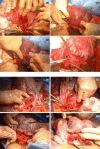Complex cesarean section: Surgical approach to reduce the risks of intraoperative complications and postpartum hemorrhage
- PMID: 39754443
- PMCID: PMC11823370
- DOI: 10.1002/ijgo.16094
Complex cesarean section: Surgical approach to reduce the risks of intraoperative complications and postpartum hemorrhage
Abstract
The incidence of cesarean section is dramatically increasing worldwide, whereas the training opportunities for obstetrician/gynecologists to manage complex cesarean section appear to be decreasing. This may be attributed to changing working hours directives and the increasing use of laparoscopy for gynecological surgical procedures, including in gynecological oncology. Various situations can create surgical difficulties during a cesarean section; however, two of the most frequent are complications from previous cesarean (myometrial defects, with or without placental intrusion and peritoneal adhesions) and the high risk of postpartum hemorrhage (uterine overdistension, abnormal placentation, uterine fibroids). Careful surgical dissection, with safe mobilization of the bladder and exposure of the anterior and lateral surfaces of the uterus, are pivotal steps for resolving the technical difficulties inherent in performing a complex cesarean section. We propose a standardized surgical protocol for women at risk of complex cesarean, including the antenatal identification of increased surgical risk, paramedian access to the pelvis, bladder dissection and mobilization, and the selection of a bleeding control strategy, considering uterine anatomy and the arterial pedicles involved in blood loss, which should be tailored to the individual case. We propose preoperative surgical planning to include consideration of the most common situations encountered during a complex cesarean, which facilitates anticipating an appropriate response for common possible scenarios, and can be adapted for low-, middle-, and high-resource settings. This protocol also highlights the importance of self-evaluation, continuous learning, and improvement activities within surgical teams.
Keywords: complex cesarean section; compressive uterine sutures; postpartum hemorrhage; protocolized treatment; surgical technique.
© 2024 The Author(s). International Journal of Gynecology & Obstetrics published by John Wiley & Sons Ltd on behalf of International Federation of Gynecology and Obstetrics.
Conflict of interest statement
The authors declare no conflicts of interest.
Figures







Similar articles
-
A new step-wise surgical technique of knapsack-like uterine compression sutures for intractable postpartum hemorrhage in cesarean section.BMC Pregnancy Childbirth. 2024 Jan 2;24(1):9. doi: 10.1186/s12884-023-06208-x. BMC Pregnancy Childbirth. 2024. PMID: 38166803 Free PMC article.
-
Random placenta margin incision for control hemorrhage during cesarean delivery complicated by complete placenta previa: a prospective cohort study.J Matern Fetal Neonatal Med. 2019 Sep;32(18):3054-3061. doi: 10.1080/14767058.2018.1457638. Epub 2018 Apr 3. J Matern Fetal Neonatal Med. 2019. PMID: 29577780
-
Parallel transverse uterine incisions, a novel approach for managing heavy hemorrhage and preserving the uterus: A retrospective cohort study for patients with anterior placenta previa and accreta.Medicine (Baltimore). 2019 Nov;98(44):e17742. doi: 10.1097/MD.0000000000017742. Medicine (Baltimore). 2019. PMID: 31689824 Free PMC article.
-
Prophylactic Intraoperative Uterine Artery Embolization During Cesarean Section or Cesarean Hysterectomy in Patients with Abnormal Placentation: A Systematic Review and Meta-Analysis.Cardiovasc Intervent Radiol. 2022 Apr;45(4):488-501. doi: 10.1007/s00270-021-02921-2. Epub 2021 Jul 19. Cardiovasc Intervent Radiol. 2022. PMID: 34282489
-
[Management of uterine myomas during pregnancy].Gynecol Obstet Fertil. 2016 Jun;44(6):350-4. doi: 10.1016/j.gyobfe.2016.04.007. Epub 2016 May 20. Gynecol Obstet Fertil. 2016. PMID: 27216952 Review. French.
References
-
- Silver RM, Landon MB, Rouse DJ, et al. Maternal morbidity associated with multiple repeat cesarean deliveries. Obstet Gynecol. 2006;107:1226‐1232. - PubMed
-
- Jauniaux E, Fox KA, Einerson B, Hussein AM, Hecht JL, Silver RM. Perinatal assessment of complex cesarean delivery: beyond placenta accreta spectrum. Am J Obstet Gynecol. 2023;229:129‐139. - PubMed
-
- Futterman ID, Conroy EM, Chudnoff S, Alagkiozidis I, Minkoff H. Complex obstetrical surgery: building a team and defining roles. Am J Obstet Gynecol MFM. 2024;6:101421. - PubMed
MeSH terms
LinkOut - more resources
Full Text Sources
Medical

